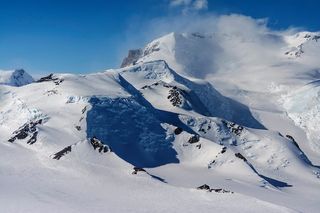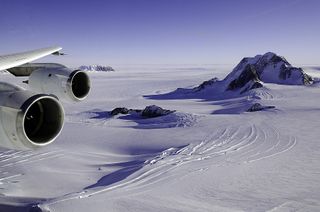Vulnerable Valleys Found Among Antarctica's Ice-Covered Volcanoes

The best look yet at the hidden, ice-covered volcanic mountains in West Antarctica's Marie Byrd Land reveals never-before-seen deep valleys and steep, glacier-carved ranges, a new study reports.
The findings, from a radar survey that can "see" through snow and ice, could force researchers to redraw maps of this famous region. Marie Byrd Land has always been pictured as a highland speckled with active volcanoes that pierce through its thick ice cap. Researchers thought this extra height protected the ice from warm ocean water that gnaws away at the rest of West Antarctica's glaciers.
But the radar instead found much of the ice in Marie Byrd Land rests below sea level. And instead of a broad plateau, the region resembles the isolated volcanic ranges of North America's Basin and Range Province in the desert Southwest. [Album: Stunning Photos of Antarctic Ice]
"Marie Byrd Land is very interesting because we have these extremely high-relief mountains next to below-sea-level topography," said lead study author Nicholas Holschuh, a glaciologist at Pennsylvania State University. "It introduces a whole new potential set of studies in this area."
In particular, DeVicq glacier flows in a valley that dives 3,280 feet (1,000 meters) below sea level, slicing across the former "plateau" near the Executive Committee Range. This glacial valley gets deeper upstream of DeVicq glacier's grounding line. (The grounding line is the boundary where the glacier leaves bedrock and extends a tongue of floating ice into the ocean.) That deepening leaves little resistance if the glacier shrinks back past the grounding line, or warm seawater slips past its ice shelf.
However, even 7.2 degrees Fahrenheit (4 degrees Celsius) of global warming can't unseat DeVicq glacier, according to the study, to be published Dec. 15 in the journal Earth & Planetary Science Letters.
Holschuh and his co-authors modeled Antarctica's future melting, using Marie Byrd Land's new bedrock topography, and found that the region's ice is still more stable than its neighbors. That's because the deepest point in the DeVicq trough is far inland from the coastline, away from the ocean's reach.
Sign up for the Live Science daily newsletter now
Get the world’s most fascinating discoveries delivered straight to your inbox.
The West Antarctic Ice Sheet contains enough ice to raise the sea level 11 feet (3.35 meters) if it all melted, the study reported. The new, deeper topography adds 3.1 inches (8 centimeters) to the estimate, bringing the new total to 11.25 feet (3.43 m), a 2 percent boost.

The clearer high- and low-topography throughout Marie Byrd Land come from a plane-mounted radar survey that flew more than 2,855 miles (4,600 kilometers) in 2009 and 2010.
Holschuh also identified another deep basin (about 3,280 feet, or 1,000 meters, below sea level) tucked next to the Executive Committee Range, the researchers reported. This mountain range shows evidence of recent volcanic stirrings, according to earthquakes picked up by seismometers on top of the ice.
And many of the high mountain peaks and ridges are cut by steep, U-shaped valleys, such as along the McCuddin Mountains, which sit between the coastline and the Executive Committee Range. This valley shape is typical of mountain glaciers. "Only erosive mountain glaciers generate these hanging valleys," Holschuh said. "A full ice sheet doesn't generate these patterns."
Marie Byrd Land's volcanoes first squeezed out lava before East Antarctica froze more than 34 years, and were especially active during West Antarctica's own big chill in the past 15 million years or so. (The continent's two halves did not ice up at the same time.) The highest peaks in Marie Byrd Land may have birthed some of West Antarctica's first glaciers, the researchers think. The spectacular hanging valleys are reminiscent of East Antarctica's Gamburtsev Mountains, which resemble the Alps but are completely buried by ice. Scientists think that mountain glaciers expanded out of the Gamburtsevs and other high-elevation areas, then melded together into ice sheets.
"We're looking back through time at active, erosive glaciers carving out these hanging valleys," Holschuh said. "That's one of the key indications we're looking at a region that was probably an initiator for growth of the West Antarctica Ice Sheet."
Follow Becky Oskin @beckyoskin. Follow LiveScience @livescience, Facebook & Google+. Originally published on Live Science.
